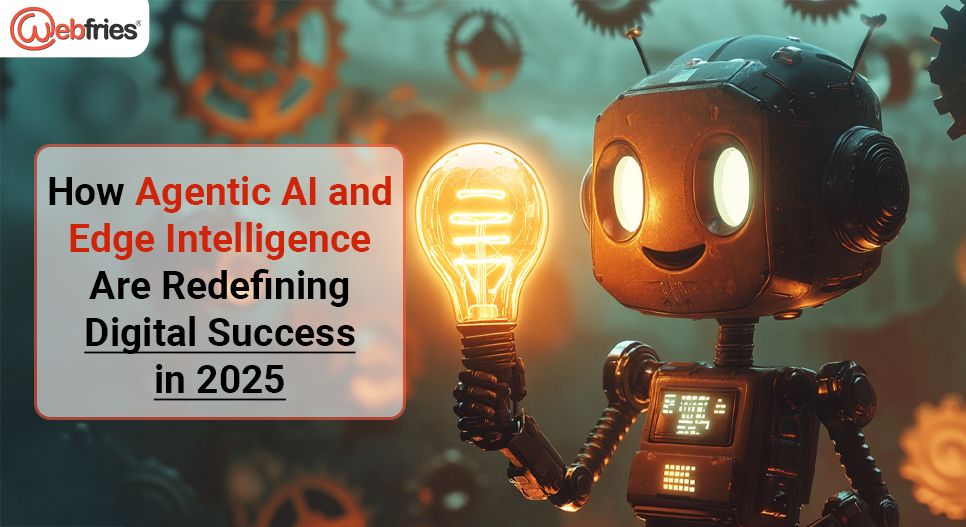Introduction: The AI Revolution Gets Autonomous
Imagine an SEO strategy that evolves faster than Google’s algorithm updates or analytics that predict market shifts before your team even logs in. This isn’t science fiction—it’s the reality of Agentic AI, a transformative shift where artificial intelligence systems act autonomously to achieve goals, learn from mistakes, and collaborate with human teams.
Traditional AI models, while powerful, are often reactive and cloud-dependent. They require constant human intervention to adjust strategies, analyze data, or respond to real-time changes. In fast-paced industries like e-commerce, finance, or healthcare, this lag can mean missed opportunities or costly inefficiencies.
Enter Agentic AI and Edge Intelligence — Two pillars of the next-gen AI revolution. Agentic systems operate with goal-driven autonomy, while edge-based small language models (SLMs) process data locally, eliminating cloud latency. Together, they empower businesses to act faster, smarter, and with unprecedented precision.
What Makes Agentic AI a Game-Changer?
A. Beyond Automation: The 4 Pillars of Agentic AI
- ▪Self-Optimization: Unlike static AI models, agentic systems iteratively improve their performance. For example, an SEO tool might autonomously adjust keyword strategies after detecting algorithm changes.
- ▪Goal-Driven Autonomy: These systems execute tasks without micromanagement. A predictive analytics platform could independently identify revenue risks and suggest mitigations.
- ▪Multi-Agent Collaboration: AI agents specializing in different domains (e.g., social media, customer support) share insights to create unified strategies.
- ▪Ethical Guardrails: Built-in safeguards ensure compliance with industry regulations, a critical feature for sectors like finance and healthcare.
B. Edge Intelligence: AI That Works Offline
Edge computing brings processing power closer to data sources—retail POS systems, factory sensors, or rural medical devices. Small language models (SLMs) optimized for edge deployment analyze data locally, reducing reliance on cloud infrastructure.
Why does this matter?
- ▪Speed: Real-time decision-making in milliseconds, crucial for fraud detection or supply chain adjustments.
- ▪Cost Efficiency: Reduces cloud storage and bandwidth expenses.
- ▪Privacy: Sensitive data (e.g., patient records) stays on-premises.
As Gartner notes, “By 2025, over 50% of enterprise data will be processed at the edge, up from less than 10% in 2021.” ¹
Real-World Impact for Indian Businesses
A. Case Study: Gurgaon E-Commerce Brand
A mid-sized Gurgaon retailer struggled with delayed campaign adjustments. Their legacy AI tools took days to analyze customer behavior, causing missed sales opportunities during peak shopping periods.
Webfries implemented an agentic AI system combining real-time edge analytics with autonomous campaign optimization. The AI adjusted PPC bids, personalized product recommendations, and refined SEO metadata—all without human intervention.
Result: The brand reported improved campaign efficiency and faster response to market trends, though specific metrics remain confidential.
B. Industry-Specific Applications
- ▪Retail: Edge AI personalizes in-store offers using smartphone sensors, avoiding cloud delays.
- ▪BFSI: Agentic fraud detection systems adapt to new scam patterns, even in offline transactions.
- ▪Healthcare: SLMs analyze wearable device data in remote areas with limited internet access.
C. The Cost of Inaction
Legacy AI systems are becoming a liability. Forrester warns that “companies relying on outdated cloud-dependent AI will face 30-40% higher operational costs by 2025.” ²
Implementing Agentic AI: A Strategic Blueprint
Adopting autonomous AI requires careful planning. Here’s a framework refined through Webfries’ work with Delhi-NCR enterprises:
- ▪Audit Workflows: Identify repetitive tasks (e.g., report generation, A/B testing) suited for autonomy.
- ▪Hybrid Integration: Blend agentic systems with human expertise. For instance, AI drafts content, while strategists refine brand voice.
- ▪Edge Infrastructure: Deploy SLMs on local servers for factories, hospitals, or retail chains.
- ▪Security First: Ensure on-premise data encryption and regular vulnerability assessments.
Pitfalls to Avoid:
- ▪Over-Automation: Reserve complex decisions (e.g., crisis management) for human teams.
- ▪Siloed Data: Use integration tools to connect edge systems with central platforms.
Gaurav emphasizes:
“The goal isn’t to replace humans but to amplify their capabilities. Our clients’ teams now focus on creative strategy while AI handles heavy lifting.”
The Future Is Autonomous: What’s Next?
The trajectory is clear: Autonomous AI will soon manage routine tasks across industries. IDC predicts “80% of repetitive marketing decisions will be AI-driven by 2026” ³, freeing teams to innovate.
For Webfries, this means democratizing access. Their OmniFries ecosystem allows startups and enterprises alike to harness agentic AI without massive upfront investments.
Your AI Partner, Not Just a Vendor
The shift to autonomous AI isn’t about chasing trends—it’s about survival. As a premier AI agent development company in Gurgaon, we empower brands to leverage agentic systems and edge intelligence – the ultimate competitive advantage in speed, efficiency, and adaptability.
As Gaurav concludes:
“We’re not just building tools; we’re crafting partnerships. Every business deserves AI that works for them, not the other way around.”
References
¹ Gartner, “The Edge Completes the Cloud” (2023)
² Forrester, “The Cost of Cloud Inefficiency” (2024)
³ IDC, “Future of Decision Automation” (2023)
⁴ SpaceX, “Starship Update” (2024)






